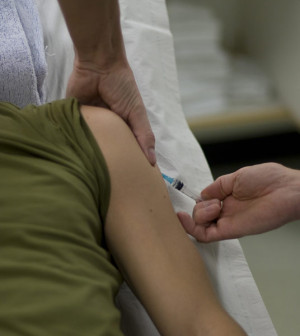- Skip Storing This Everyday Product in the Fridge Door
- Green Tea + B3 Pairing May Boost Brain Health
- Navigating Your Midlife Crisis: Embracing New Possibilities
- City Raccoons Showing Signs of Domestication
- Mapping the Exposome: Science Broadens Focus to Environmental Disease Triggers
- One Week Less on Social Media Linked to Better Mental Health
- Your Brain Changes in Stages as You Age, Study Finds
- Some Suicide Victims Show No Typical Warning Signs, Study Finds
- ByHeart Formula Faces Lawsuits After Babies Sickened With Botulism
- Switch to Vegan Diet Could Cut Your Greenhouse Gas Emissions in Half
Texas Woman’s Death Highlights Danger of Overlooking Dengue Fever


The case of a Texas woman who died after becoming infected in New Mexico with the mosquito-borne dengue virus highlights a need for U.S. doctors to recognize the disease early, experts say.
Dengue fever is an excruciating and sometimes fatal illness for which there is no vaccine, according to the U.S. Centers for Disease Control and Prevention. The disease is endemic in much of the tropics, but cases on American soil typically have involved travelers who have “imported” the disease after having been infected elsewhere.
Although the disease cannot move from person to person, mosquitoes are able to pick up dengue from infected patients and, in turn, spread the disease among a local populace, according to the CDC.
In a new report, researchers led by CDC epidemiologist Tyler Sharp described what happened to a 63-year-old Texas woman who became ill in August 2012 after taking a one-month vacation to New Mexico. After returning home, the woman was initially — and erroneously — diagnosed with West Nile virus.
On Sept. 22, 2012, the woman went to an emergency room because she had persistent fatigue, fever and chills. She was admitted to the hospital and died Oct. 3 from a rare complication of dengue called hemophagocytic lymphohistiocytosis, according to the report.
This is the third locally acquired dengue-related death in the United States and the first dengue-associated hemophagocytic lymphohistiocytosis case recorded in the nation, the researchers reported in the Jan. 24 issue of the CDC journal Morbidity and Mortality Weekly Report.
They said this case suggests there may be more unrecognized cases of dengue in the United States.
For decades, dengue fever had been thought of as an illness that people contracted outside the United States. But that all changed in 2009 and 2010, when a cluster of cases were reported in southern Florida.
Speaking to HealthDay in 2011, as the Florida outbreak was subsiding, Dr. Hal Margolis, chief of the CDC’s dengue branch, said most dengue that appears in the United States is still brought back by people who have traveled to areas in the world where the disease is endemic.
“There are thousands of people who come back with dengue,” he said. “That’s really the biggest problem.”
There also are sporadic outbreaks along the Texas-Mexico border, Margolis said. In addition, dengue is endemic in some areas of the United States, such as Puerto Rico, the U.S. Virgin Islands and Asian territories such as Guam and American Samoa, he said.
The Florida outbreak was unusual in that it lasted for two seasons, Margolis said. “How it got introduced, we don’t know,” he said.
The disease can cause a high fever and people can feel sicker than they have ever felt before, Margolis said. “The danger comes in those people who get severe dengue; that usually happens with a second or third infection,” he said. “Twenty-five percent of people who have first infections may go on to have severe dengue.”
In severe dengue, plasma leaks out of the blood vessels, ending up around the lungs and abdomen, and infected people can develop shock, Margolis said. About 15 percent of people have these severe signs, he said, and about 1 percent die.
According to an editorial accompanying the new report, people “living in or traveling to areas where a risk for dengue exists should avoid mosquito bites by using insect repellent, staying in residences with air conditioning or intact mosquito screens on windows and doors, and emptying or covering all water containers that can serve as mosquito breeding sites.”
More information
The U.S. National Institute of Allergy and Infectious Diseases has more about dengue fever.
Source: HealthDay
Copyright © 2025 HealthDay. All rights reserved.










